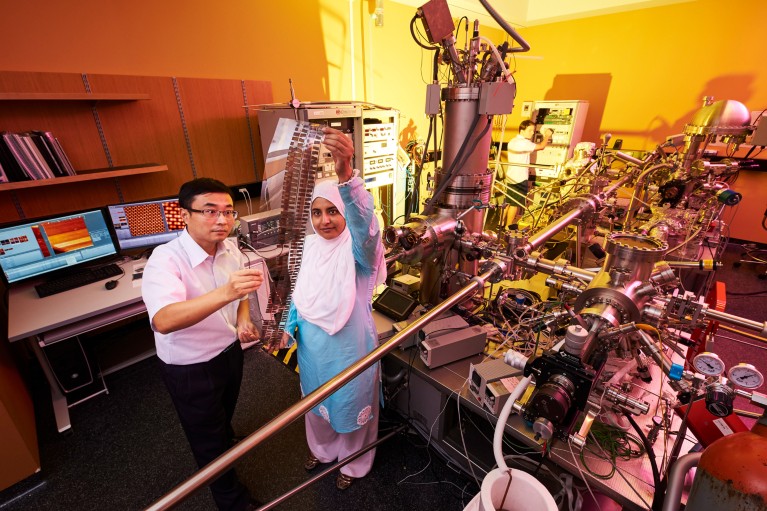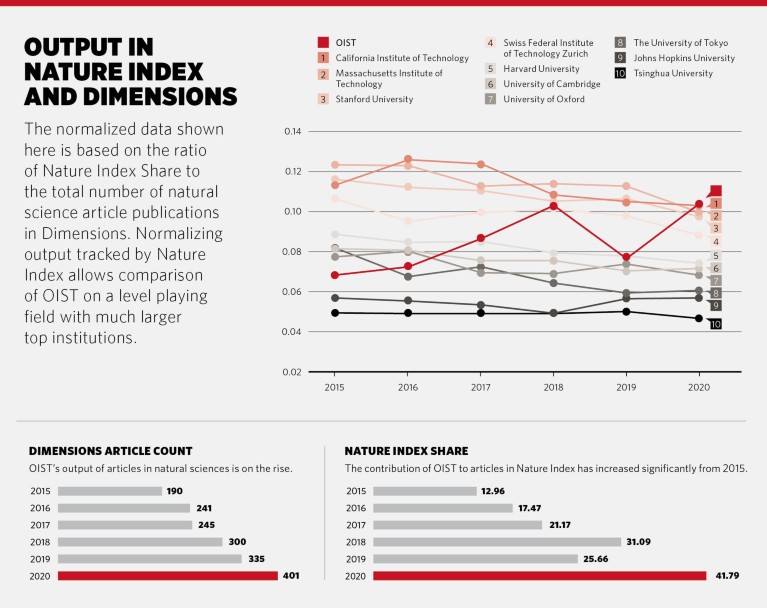
Yabing Qi (left) examining a perovskite solar cell with student, Afshan Jamshaid.© Okinawa Institute of Science and Technology Graduate University/Togo
Celebrating its 10th anniversary year in 2021, the Okinawa Institute of Science and Technology Graduate University (OIST) performs at the level of the world’s leading research institutions in the Nature Index, on a normalized basis. Normalization, which expresses the share of an institute’s output that appears in the selective Nature Index as a fraction of their broader output, is a way of adjusting for the size of an institute. The last 10 years have seen OIST’s article count increasing steadily, with its normalized share surpassing that of Caltech, MIT and Stanford in 2020, the most recent year for which complete data was available.
Peter Gruss, formerly the head of Germany’s Max Planck Society, has been president and chief executive of OIST since January 2017. He attributes the success of OIST to its decision to invest in people instead of projects. Researchers are given five years of funding and can spend it as they see fit, after which they are rigorously reviewed. Another important factor is the university’s structure, which encourages interdisciplinary interactions.
“We have no departments, so there are no barriers between different scientific fields, giving our scientists the freedom and flexibility to conduct multidisciplinary, creative and high-stakes research that they are passionate about,” says Gruss. “This ‘high-trust’ funding and unique interdisciplinary environment, along with using English as the common language, allows us to recruit talented scientists from across the world, with 62% of our faculty coming from overseas. In turn, our world-class professors attract top-quality students and generate new innovations, thus building up the three pillars of OIST’s mission — research excellence, education and innovation.”

Reinventing solar panels
Located in Okinawa, a Japanese island in the Pacific Ocean, OIST is one of many coastal communities facing the consequences of climate change. One example of excellence in research at OIST that is helping to address this global challenge is the work of Yabing Qi, a professor in the Energy Materials and Surface Sciences Unit. Qi and collaborators are developing solar cells made of materials called ‘metal halide perovskites’.
To convert sunlight into electricity, conventional photovoltaic cells use silicon arranged in a crystal lattice. The advantage of perovskite is that it can be printed, coated or vacuum-deposited onto a substrate at a low cost. Qi and his colleagues have already developed metal halide perovskite modules with efficiencies exceeding 16%, and he says 25% has also been achieved by others on smaller areas, which is comparable to commercial silicon cells. Most perovskite cells are smaller than 0.3 cm2, so Qi and his team are currently working to upscale them to larger than 200 cm2 to facilitate their commercialization.
“These materials possess excellent optoelectronic properties and metal halide perovskite is a very promising candidate for solar cell applications,” says Qi, who joined OIST 10 years ago. “My research in this area benefits from the fact that OIST does not have departments. If I have an idea, I sound out my colleagues, and we formulate approaches for working together. And OIST strongly supports the development of new technology.”
New insights into hurricanes
Okinawa is regularly lashed by typhoons. Inspired after witnessing their enormous power when he joined OIST in 2012, heading the Fluid Mechanics Unit, Pinaki Chakraborty and colleague, Lin Li, began looking into how these storms behave after they make landfall. Hurricanes are fuelled by ocean moisture, but little is known about how they decay on land. Looking at 50 years of data, they found that decay has slowed in proportion to a rise in sea surface temperature: in the late 1960s, a hurricane lost about 75% of its intensity in the first day after landfall, but now that’s only about 50%. In later research, the pair found a colder region in the eye forms in all landfalling hurricanes, influencing how they decay. Chakraborty and Li’s work could potentially save billions of dollars in storm damage, by more accurately predicting the path of landfalling hurricanes, including into mainland Japan.
“More and more inland regions, which are not prepared like coastal areas, are going to experience more intense hurricanes,” says Chakraborty, who was new to meteorological research before exploring hurricane intensity. “My background is turbulent flows, and I would not have predicted that landfalling hurricanes would be an interesting area to dig into because I didn’t know the key connection to global warming. The high-trust funding structure at OIST allows us to do high-risk research where you’re working on a problem that opens up new avenues.”
Growing and giving back
This kind of serendipitous discovery is what OIST is all about. It plans to expand its research output by adding faculty and students while contributing more to the local community. OIST is developing an innovation park concept near the campus aimed at launching start-ups, including those supporting sustainable development.
“We hope to bolster and diversify the Okinawan economy,” says Gruss. “To achieve greater impact, as recommended by an external panel earlier this year, we need to grow to the point of optimal collaboration and discovery. For research and education, we hope to increase the number of faculty from about 80 to 300 over the next 10 to 20 years and take in larger cohorts of students to maintain the ratio of three students per professor.”
As OIST reaches its growth goals, Gruss says he is looking forward to its contribution to Okinawa, Japan and the world. “OIST’s vision is the advancement of knowledge for the benefit of humanity,” he says. “We want OIST to become one of the best universities in the world.”



 Nature Index 2021 Young Universities
Nature Index 2021 Young Universities